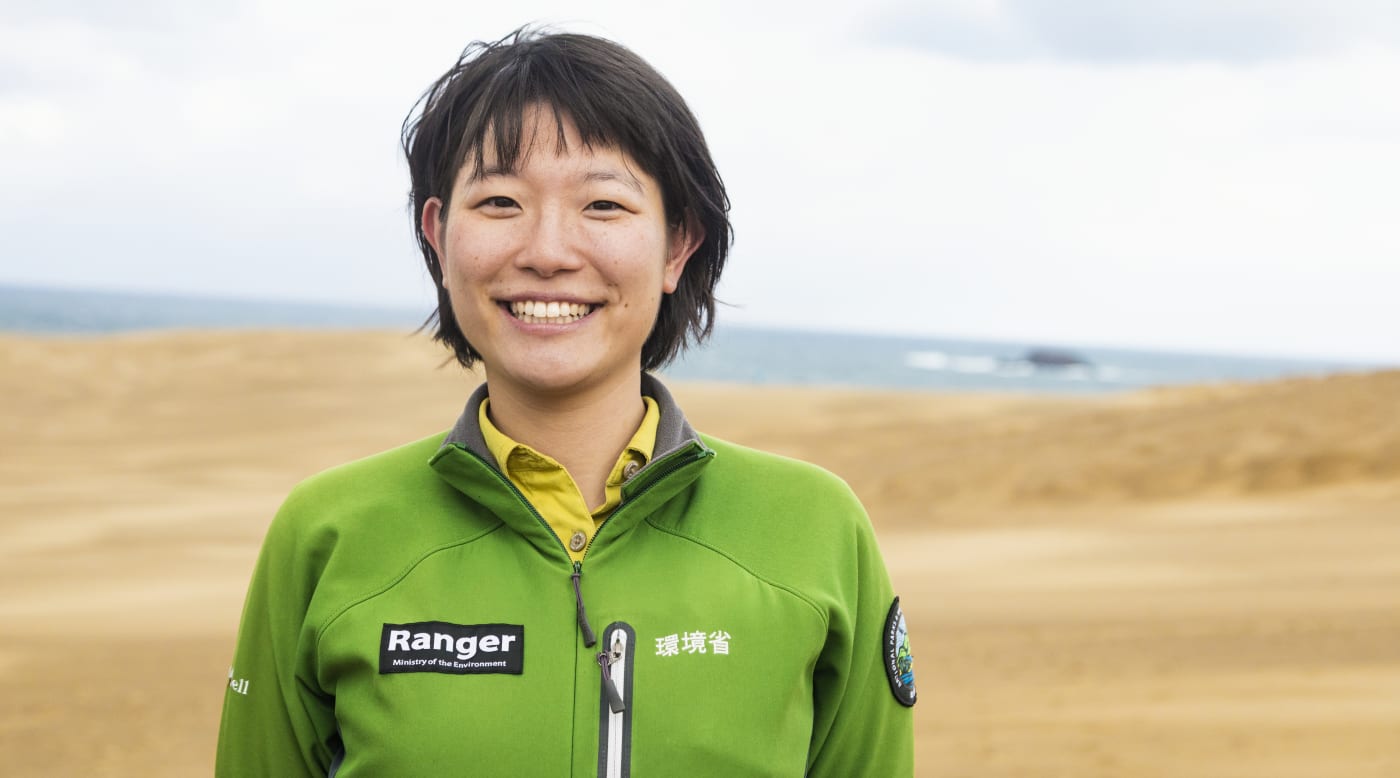Park ranger Aya Genseki’s passion for conserving the surprising coastal landscape of San’inkaigan National Park shines through in both her work and play
| Ranger | Aya Genseki |
| Park | San’inkaigan National Park |
| Recommended Spot | Shirawara Kaigan and Kamogaiso Beaches |
* This article was written based on an interview conducted with the park ranger in December, 2019.

Aya Genseki has worked in several different national parks across Japan during her career as a park ranger, gaining a wide range of experience conserving precious flora and fauna in wildlife protection areas.
Previously, she helped protect Japan’s native species by controlling the entry of nonnative plants, insects and animals while working at the Narita Nature Conservation Office at Narita Airport. Alien species can have a significant impact on Japan’s biodiversity, driving away native species and threatening their habitats, so eliminating invasive plants and animals is a huge task for the Ministry of the Environment. At Narita, fire ants brought in with packages have been a common concern because their bites cause a burning sensation and fever. The rangers and staff at Narita dealt with this problem by disinfecting items arriving from overseas.
Now, Genseki brings her expertise to her latest post at San’inkaigan National Park, where her focus is protecting the marine and coastal environment of the area. She says she’s eager to explore the park, which she calls “one of Japan’s most surprising landscapes,” from its clear waters to its unique sand dunes.
Falling in Love with the Sea
San’inkaigan National Park encompasses a 75-kilometer stretch of coastline along the Sea of Japan, from the city of Tottori, in Tottori Prefecture to Kyotango in Kyoto Prefecture. Genseki considered herself to be more of a “mountain person” before moving to Tottori, preferring hikes in the forest and mountain vistas. But the clear, beautiful waters and marine life of San’inkaigan have changed her perspective. Now she goes snorkeling whenever she has the opportunity.
“When I discovered you could do so many water sports here, like sea kayaking, stand-up paddleboarding and snorkeling, I wanted to give them a try," she says. "When I first saw colorful sea anemones attached to rocks beneath the water, I realized that there was a world of fascinating life in these waters.”

Some of Genseki’s favorite places to go snorkeling in the park are Shirawara Kaigan and Kamogaisou, a collection of coves and beaches along the Uradome Coast. Genseki says that a lot of visitors come to this area in summer, but she recommends coming in September and October when there are far less people and the water is still clear and calm.
Cleaning Up the Coast
The rocky landscape of San’inkaigan was shaped by strong winter winds and the Sea of Japan’s powerful waves. The water is beautiful and calm in spring, summer and fall, but from November to April the conditions are too dangerous to swim, snorkel or kayak. The rough sea washes up garbage from the ocean, and keeping the coastline clean is a big problem for Genseki and her colleagues. They request that the Ministry of the Environment carry out massive beach cleanups regularly, engaging the help of the local governments of Tottori Prefecture and Tottori City. This usually happens in spring and summer. Throughout the year, tour operators, fisherfolk and other volunteers also clean various sections of coastline.
Protecting the Dunes
The Tottori Sand Dunes (Tottori Sakyu) are one of the most popular attractions in San’inkaigan National Park. These dunes are the largest in Japan, stretching 16 kilometers along the coast and 2.4 kilometers inland.
“You might wonder how all of this sand got here,” Genseki says. She explains that the dunes were created over thousands of years as runoff carried sand inland from the mountains to the Sendaigawa River, which flows into the sea. Waves redeposited the sand onto the shore, creating dunes up to 50 meters high.

Genseki says that human development, such as the construction of bridges and buildings along the riverbank and coastline, has slowed the accumulation of sand in the Tottori Sand Dunes. To combat this, Tottori Prefecture has a sand-recycling program, which is also known as "beach nourishment." Sand that has built up in large amounts in other areas of the coastline is transported to the shore along the Tottori Sand Dunes. The wind carries the sand onto the dunes, preserving their natural state.
Finding Beauty in the Sand

Although it seems like nothing grows or lives in the sand dunes, Genseki says that insects, plants and animals such as rabbits and boars make their homes there. She has never observed any animals in the dunes, but does sometimes see their footprints in the sand.
“I’ve really fallen in love with the Tottori Sand Dunes. If you look at them long enough, you'll notice beautiful structures in the dunes, shapes created by the wind, and the sand itself. It’s as if new art is being created from moment to moment. I find this place so mesmerizing.”